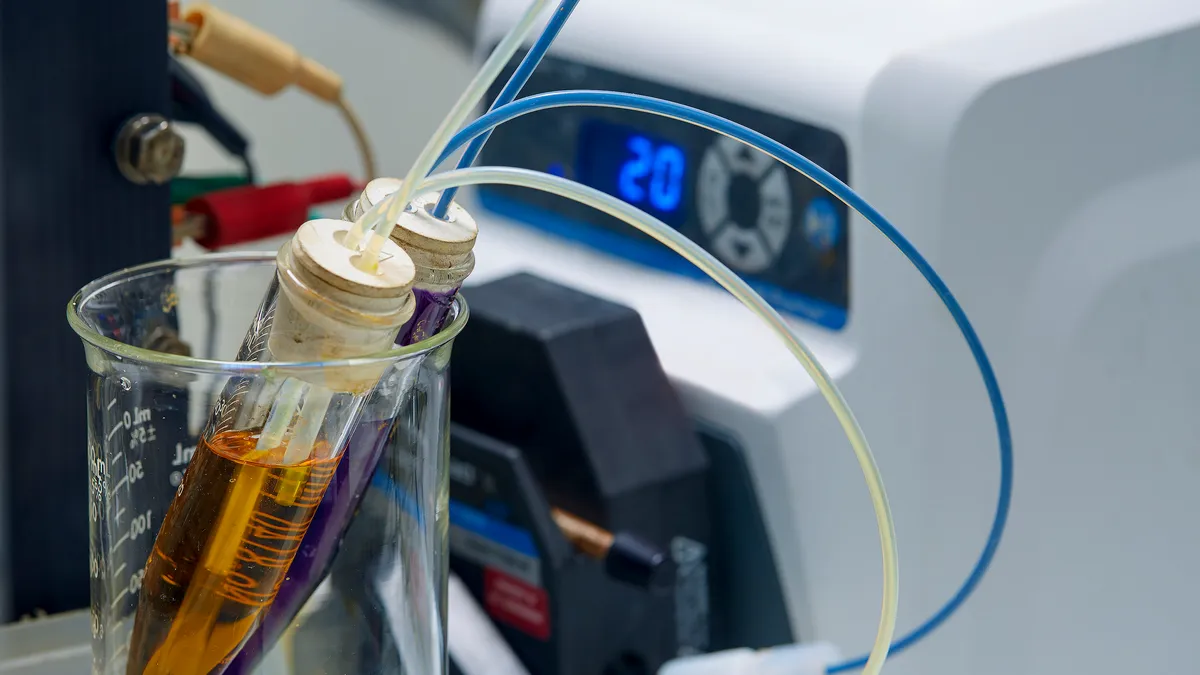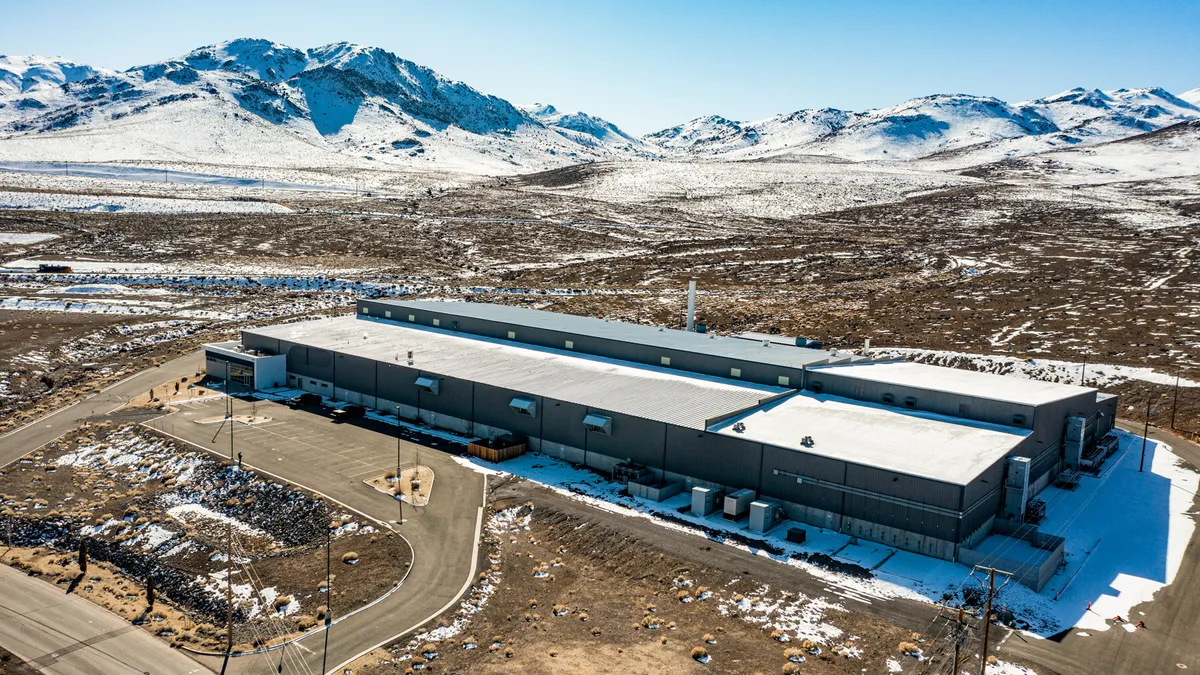Recent technical advances are sparking interest in flow batteries by offering the promise of significant cost reductions that could make them better able to compete for market share with solid state storage devices, such as the nearly ubiquitous lithium-ion battery. But full commercialization is still several years off, analysts say.
Worldwide, li-ion batteries represent about 70% of grid-connected battery installations, according to the Department of Energy.
Li-ion’s challenger in the flow battery category is the vanadium-based battery, which accounts for nearly 79% of worldwide flow battery installations.
“Flow batteries have potential and are a good option for some longer duration applications, but they aren’t likely to reach equal market share with solid state batteries for a while,” Colette Lamontagne, a director in the energy practice at Navigant Consulting, says.
Flow batteries generate power by pumping electrolytes from storage tanks to a central stack where the interchange between positive and negative electrolytes creates an electrical charge.
Because the electrolytes can be returned to their respective storage tanks, flow batteries have a more flexible and resilient cycling characteristics than solid state batteries. They can withstand deeper discharge cycles and longer life cycles, making them better suited for long duration applications than most solid state batteries.
Electrolyte storage also allows for great independence of energy and power characteristics. Flow batteries also can be scaled to meet varying requirements more easily than can solid state batteries. The volume of stored electrolytes can be increased or the volume of electrolytes pumped into the stack can be increased. More electrolyte stored in larger tanks translates into the possibility of longer duration applications, a capability that industry analysts expect to drive deployment for storage facilities in years to come.
But flow batteries also have lower efficiencies and larger footprints than solid state batteries. Li-ion batteries have efficiency levels in the high 90% range while the efficiency of flow batteries is in the 75% to 80% range, in part because they incur a parasitic load to run pumps. Flow batteries also have higher operational costs because they involve more moving parts, including membranes that wear out.
Those considerations make is hard to come up with simple cost comparisons. “You need to think of the application when you compare flow and solid state batteries,” Lamontagne says, adding that, because of their footprint, location also matters.
Proof of Concept
“There is going to be growth in flow batteries over the next couple of years,” but the technology still is going through the “commercial proof of concept” phase, Brett Simon, energy storage analyst at GTM Research, told Utility Dive.
Several projects, both research and demonstration, are working to hasten that process. Late in December, researchers at Pacific Northwest National Laboratory (PNNL) said new materials technology could cut standard flow battery costs by up to 60%. The researchers said an organic aqueous flow battery they are developing is expected to cost $180/kWh once the technology is fully developed. Vanadium-based batteries, for reference, currently cost about $450/kWh.
The key to the cost reductions is the substitution of high cost transition metal elements, vanadium for instance, for lower cost synthetic materials that can be sourced from existing chemicals already widely used in industry.
PNNL's new flow battery features two main electrolytes, a methyl viologen anolyte (negative electrolyte) and a catholyte (positive electrolyte) called TEMPO for short.
Viologens are widely used in the pesticide industry, and TEMPO is used as an industrial catalyst.
"Using readily available materials makes our all-organic aqueous flow battery more sustainable and environmentally friendly,” Wei Wang, a senior scientist at PNNL, said. The goal, he told Utility Dive, is to reach the DOE target of $100-150/kWh.
In tests using a 600-milliwatt battery, Wang and his colleagues found that about 70% of the organic aqueous battery's original voltage was retained and that it continued to operate well beyond 100 cycles.
The researchers plan to make a larger version of their test battery, one that is able to store up to 5 kW. They are also working on improving the battery's cycling so it can retain more storage capacity for a longer time.
PNNL has been through this cycle before. One of the reasons for vanadium-based batteries’ widespread adoption was the introduction a new vanadium battery design introduced by PNNL in 2011 that increased storage capacity by 70%.
Three different companies have licensed the technology behind PNNL's vanadium design. One of those companies is UniEnergy Technologies, which in late December landed $25 million in funding from Orix, a Japanese financial services firm.
UET built the largest-capacity flow battery system in North America, a 1-MW, 4-MWh vanadium redox flow battery for Avista in Pullman, Washington, to support Washington State University’s smart campus operations by providing load shifting, frequency regulation, and voltage regulation.
Wang says PNNL is in talks with several companies – he can’t disclose their names – that are interested in the commercial application of the lab’s organic aqueous technology. He could not give an exact time frame, but he hopes a licensing agreement will be in place by year end.
PNNL’s improved vanadium technology was scaled from 1 kW to 5 kW in three to four years, says Wang. He estimates that commercialization of organic aqueous technology could be two or three years away.
Wang also noted that PNNL’s water-based liquid electrolytes are designed to be a drop-in replacement for current flow battery systems. The owners could drain their more expensive electrolytes and replace them with the cheaper organic aqueous electrolytes, he said.
Competing Technologies
That drop-in capability could be a good selling point for PNNL’s technology. There are more than 20 flow battery chemistries vying for market dominance. Zinc-bromine, zinc-cerium, and magnesium-vanadium all are being studied, but the most researched and closest to commercialization is the vanadium redox flow battery.
In addition to UET’s project in Washington, Vionx Energy is conducting a vanadium demonstration project for the U.S. Army at Fort Devons. In Canada, Ontario’s Independent Electricity System Operator recently signed contracts for energy storage, including a 10-year contract with SunEdison for a 5-MW system that will use Imergy’s vanadium redox technology.
It is notable, however, that materials comprise only 30% to 60% of flow battery costs. The stack represents about 40% of the costs. The remaining 20% is mostly the cost of the membrane. So advances in materials alone may not be enough to make flow batteries competitive with solid state batteries.
But flow batteries have another edge when compared with solid state systems.
Even though flow batteries have been targeted for longer duration projects, Wang notes that flow batteries also work well in short duration applications. “We have data that show that vanadium redox batteries follow the supply closely. They are more than capable for use in voltage regulation applications” he says.
Meanwhile, other technologies also are in development. Red Flow is pairing its zinc-bromine battery with renewable energy in off-grid applications in the Australian outback and is increasing the size of their systems and marketing it for industrial applications.
Primus Power has demonstrated its zinc-bromine flow battery through the U.S. DOE Smart Grid Demonstration Program. Under the same program, Enervault has demonstrated an iron-chromium flow battery.
In a November paper, scientists in Singapore said they had developed a redox flow lithium battery with energy densities that match those of their lithium-ion counterparts.
But evaluating an energy storage system is more complicated than simply evaluating the relative costs. The value is use-specific; it depends on how the storage system is going to be used. And, as the various chemistries move closer to commercialization, flow batteries will likely be able tout their operational flexibility, as well.
Being able to move fluidly between short and long duration applications could enhance the economics of flow batteries, analysts say. A single system that can provide both voltage regulation and load shifting could have an edge over systems that are limited to a single function.






















